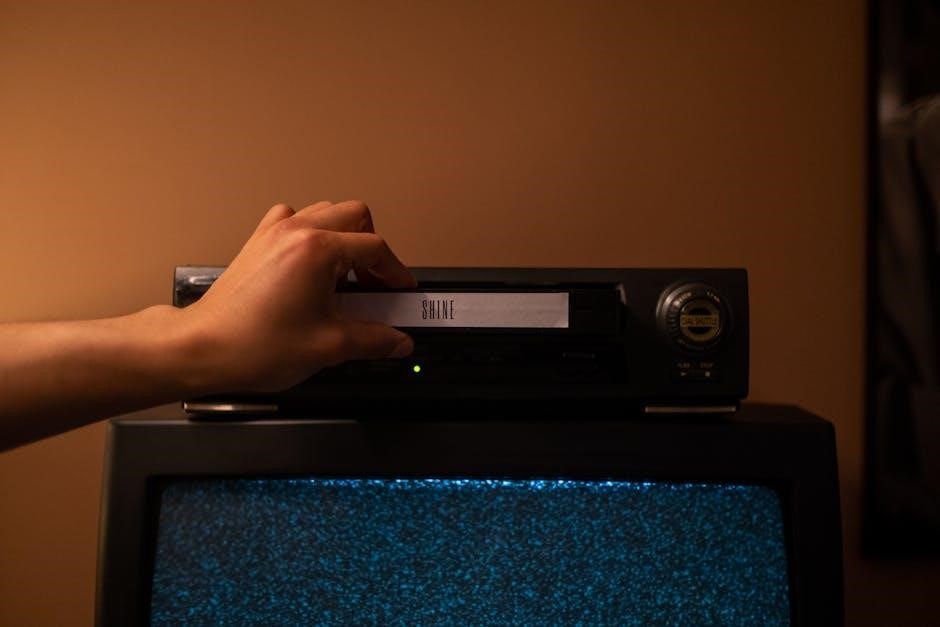Honeywell T775 Manual: A Comprehensive Guide
The Honeywell T775 manual offers a comprehensive resource for understanding and utilizing the T775 series electronic stand-alone controllers. This guide provides detailed information on applications‚ wiring‚ programming‚ and troubleshooting‚ ensuring optimal performance within commercial and agricultural settings‚ when controlling temperature and more.
Overview of the Honeywell T775 Series
The Honeywell T775 series represents a line of advanced electronic stand-alone controllers designed for versatile applications in remote temperature sensing and control. These controllers are engineered to provide accurate and reliable performance in diverse environments‚ including commercial buildings and agricultural facilities. The T775 series is capable of managing temperature‚ humidity‚ and pressure‚ making it a suitable choice for various control needs.
These controllers support multiple sensor inputs and offer flexible output options‚ including Electronic Series 90‚ 4 to 20 mA‚ and 0 to 18 Vdc‚ for controlling damper and valve actuators. With features like EEPROM for saving programmed values during power outages‚ the T775 ensures consistent operation. The series is designed for easy installation and configuration‚ offering a user-friendly interface. The T775 series enhances control precision and adaptability for a wide range of applications.
Honeywell’s T775 series offers solutions to meet the demands of modern control systems.
T775 Series 2000 Electronic Stand-Alone Controllers

The Honeywell T775 Series 2000 electronic stand-alone controllers represent a significant advancement in universal control technology‚ designed for remote sensing applications. These controllers are engineered to provide reliable temperature‚ humidity‚ and pressure management in commercial‚ industrial‚ and agricultural settings. With a focus on accuracy and ease of use‚ the T775 Series 2000 offers versatile control options for various systems‚ including heating‚ ventilation‚ and air conditioning (HVAC) systems.

The T775 Series 2000 supports a variety of sensor inputs and output types‚ allowing for seamless integration with existing infrastructure. Key features include programmable setpoints‚ alarm functions‚ and communication capabilities‚ enhancing operational efficiency and system monitoring. The controllers are designed to maintain programmed values even during power outages‚ thanks to the EEPROM‚ ensuring consistent performance.
Honeywell’s T775 Series 2000 controllers provide a reliable solution for precise control in diverse applications‚ offering enhanced accuracy and operational capabilities. The controllers are engineered for long-term reliability and adaptability.
Key Features and Functionality
The Honeywell T775 series boasts a range of key features designed for optimal control and efficiency. Its ability to remotely sense temperature‚ humidity‚ and pressure makes it a versatile solution for diverse applications. One notable feature is its compatibility with various sensor types‚ allowing for flexible integration into existing systems. The controller supports multiple input and output options‚ including 4 to 20 mA‚ 0 to 18 Vdc‚ and Electronic Series 90‚ enabling precise modulation of damper and valve actuators.
The T775’s internal EEPROM ensures that programmed values are saved and restored after power outages‚ maintaining operational consistency. Furthermore‚ the device offers programmable setpoints and alarm functionalities‚ enhancing control and monitoring capabilities. For applications requiring averaging temperatures across large spaces‚ the T775 supports parallel-series wiring of multiple sensors‚ improving accuracy and response.
With its advanced sensing capabilities and versatile control options‚ the Honeywell T775 is engineered to deliver reliable and precise performance. These features ensure seamless integration into various systems‚ providing optimal control and efficiency for diverse applications.
Applications of the T775 Controller
The Honeywell T775 controller serves a multitude of applications across diverse industries‚ offering precise control in various environmental conditions. In commercial buildings‚ it effectively manages HVAC systems‚ optimizing temperature and humidity for enhanced comfort and energy efficiency. Its remote sensing capabilities make it ideal for monitoring conditions in ducts‚ tanks‚ and chillers‚ ensuring consistent performance.
Water source heat pump loops benefit from the T775’s ability to maintain stable temperatures‚ improving overall system efficiency. In agricultural settings‚ the controller can regulate temperature in greenhouses and storage facilities‚ protecting crops and produce. Furthermore‚ the T775 is suitable for industrial processes requiring precise temperature control‚ such as manufacturing and chemical processing.
The T775’s versatility extends to applications involving damper and valve actuators‚ providing accurate modulation based on environmental conditions. Its compatibility with various sensor types allows for seamless integration into existing systems. Whether in commercial‚ agricultural‚ or industrial environments‚ the Honeywell T775 controller delivers reliable and precise control‚ optimizing processes and enhancing operational efficiency.
Remote Temperature Sensing Capabilities
The Honeywell T775 controller excels in remote temperature sensing‚ providing accurate and reliable measurements from distant locations. Utilizing sensors like the 193987GA‚ the T775 can effectively monitor temperatures up to 1000 feet (304m) away‚ making it suitable for large facilities and remote installations. Standard AWG 18/2 unshielded wire can be used for shorter runs‚ while shielded cable is recommended for distances exceeding 25 feet to minimize interference.
This remote sensing capability allows the T775 to be strategically placed in areas where temperature monitoring is critical‚ such as ducts‚ tanks‚ and large open spaces. Multiple sensors can be wired in parallel-series configurations to sense average temperatures across expansive areas‚ ensuring consistent and representative readings. The high accuracy of the T775 ensures minimal differential between controllers‚ enhancing overall system performance.
By leveraging remote temperature sensing‚ the T775 enables precise control and optimization of HVAC systems‚ industrial processes‚ and agricultural environments. This feature is particularly valuable in applications where physical access is limited or where continuous monitoring is essential for maintaining optimal conditions.
Controlling Damper and Valve Actuators
The Honeywell T775 controller is designed to seamlessly control damper and valve actuators‚ providing precise modulation for optimal system performance. The T775 supports a variety of input signals‚ including Electronic Series 90‚ 4 to 20 mA‚ and 0 to 18 Vdc‚ ensuring compatibility with a wide range of actuator types. This versatility allows for flexible integration into existing HVAC systems and industrial processes.
By modulating damper and valve actuators‚ the T775 enables precise control over airflow and fluid flow‚ allowing for efficient regulation of temperature‚ pressure‚ and other critical parameters. This capability is essential for maintaining optimal conditions in various applications‚ such as commercial buildings‚ industrial facilities‚ and agricultural environments. The controller’s ability to accept different input signals simplifies wiring and configuration‚ making it easy to adapt to specific system requirements.

The T775’s control over actuators contributes to energy efficiency and cost savings by ensuring that systems operate at their optimal levels. Precise modulation minimizes waste and improves overall system responsiveness‚ leading to more stable and efficient operation. This feature makes the T775 a valuable tool for enhancing the performance and sustainability of controlled environments.

Wiring and Installation Guide
The wiring and installation of the Honeywell T775 controller are critical steps in ensuring its proper operation. Each T775 controller must be wired to its own dedicated sensors to maintain accuracy and prevent interference. The T775 series controllers are designed for remote sensing of temperature and other parameters‚ requiring careful attention to wiring practices to avoid signal degradation.
For sensor connections‚ the manual recommends using appropriate gauge wiring to minimize resistance and ensure accurate readings. For cable runs exceeding 25 feet‚ shielded cable is recommended to reduce the impact of electromagnetic interference. The 193987GA Sensor can be located up to 1000 feet (304m) from the T775 when using standard AWG 18/2 unshielded wire. Proper grounding is also essential to prevent electrical noise from affecting the controller’s performance.
The installation guide provides detailed diagrams and instructions for connecting power‚ sensors‚ and output devices. Following these instructions carefully is crucial for avoiding wiring errors that can lead to inaccurate readings or system malfunctions. The manual also includes guidance on mounting the controller in a suitable location‚ ensuring it is protected from environmental factors that could affect its operation. Adhering to the wiring and installation guidelines outlined in the T775 manual will help ensure reliable and accurate control of your system.

Wiring Multiple Sensors in Parallel-Series
The Honeywell T775 controller supports the wiring of multiple sensors in a parallel-series configuration‚ allowing for the averaging of temperatures across a larger area. This is particularly useful in applications where temperature variations exist within a space‚ and a representative average temperature is desired for control purposes. When wiring sensors in parallel-series‚ it is crucial to maintain control and ensure that the overall resistance of the sensor network remains within the acceptable range for the T775 controller.
The T775 manual provides detailed guidance on how to properly wire sensors in this configuration‚ including considerations for sensor placement and wiring techniques. It emphasizes the importance of using matched sensors to minimize errors and ensure accurate temperature averaging. Additionally‚ the manual outlines the calculations necessary to determine the total resistance of the parallel-series network‚ which must be within the specified limits for the T775 controller to function correctly.
Properly implementing a parallel-series sensor configuration requires careful planning and attention to detail. The T775 manual serves as a valuable resource‚ providing the necessary information to ensure that the sensor network is wired correctly and that the controller receives an accurate representation of the average temperature within the controlled space. By following the guidelines outlined in the manual‚ users can effectively utilize this feature to enhance the performance of their T775-based control system.

Sensor Placement and Wiring Considerations
Proper sensor placement and wiring are critical for the accurate and reliable operation of the Honeywell T775 controller. The T775 manual provides detailed guidance on these aspects‚ emphasizing the importance of selecting appropriate sensor locations that accurately represent the temperature being controlled. Sensors should be positioned away from direct sunlight‚ drafts‚ and other sources of localized temperature variations that could skew readings.
Wiring considerations are equally important. The manual recommends using appropriate gauge wire to minimize signal loss and ensure accurate temperature sensing. For longer cable runs‚ shielded cable is recommended to reduce the effects of electromagnetic interference. The manual also provides specific wiring diagrams and instructions for connecting sensors to the T775 controller‚ including information on terminal assignments and grounding techniques.
Furthermore‚ the T775 manual addresses the importance of proper wire management and strain relief to prevent damage to the wiring and ensure long-term reliability. It also advises against running sensor wires alongside high-voltage power cables‚ as this can introduce noise and interference into the sensor signal. By following the recommendations outlined in the T775 manual‚ users can ensure that their sensors are properly placed and wired‚ resulting in accurate temperature readings and reliable control system performance.
Using AWG Wire and Shielded Cables
The Honeywell T775 manual specifies the use of appropriate American Wire Gauge (AWG) wire for connecting sensors and actuators to the controller. Selecting the correct AWG wire is crucial for ensuring proper signal transmission and minimizing voltage drop‚ which can affect the accuracy of temperature readings and the performance of connected devices. The manual typically recommends using AWG 18/2 unshielded wire for sensor connections up to 1000 feet.
For cable runs exceeding 25 feet‚ the T775 manual strongly advises the use of shielded cables. Shielded cables provide protection against electromagnetic interference (EMI) and radio frequency interference (RFI)‚ which can distort sensor signals and cause erratic controller behavior. The shield should be properly grounded at one end to effectively divert unwanted noise away from the signal conductors.
The T775 manual also provides guidance on selecting the appropriate type of shielded cable based on the specific application and environmental conditions. Factors to consider include the cable’s voltage rating‚ temperature rating‚ and resistance to moisture and chemicals. By adhering to the wiring recommendations outlined in the T775 manual‚ users can ensure reliable and accurate operation of their T775 controller and connected devices.
Programming and Configuration
The Honeywell T775 manual provides detailed instructions for programming and configuring the controller to meet specific application requirements. The manual outlines the various parameters that can be adjusted‚ including setpoints‚ proportional bands‚ integral times‚ and derivative times. Understanding these parameters is crucial for optimizing the controller’s performance and achieving precise temperature control.
The T775 manual guides users through the process of navigating the controller’s menu system and entering the desired parameter values. It also provides explanations of the different control modes available‚ such as on/off control‚ proportional control‚ and PID control. Selecting the appropriate control mode is essential for achieving stable and accurate temperature regulation.
Furthermore‚ the T775 manual includes information on configuring the controller’s input and output settings. This includes assigning sensor inputs to specific control functions and configuring the output signals to drive actuators‚ valves‚ and other devices; The manual also covers advanced programming features‚ such as scheduling and alarming‚ which can be used to automate control processes and provide alerts in case of abnormal conditions.

Saving and Restoring Programmed Values

The Honeywell T775 series controllers are equipped with the ability to save and restore programmed values‚ ensuring that settings are not lost during power outages or system maintenance. This feature is crucial for maintaining consistent operation and minimizing downtime. The T775 utilizes an EEPROM (Electrically Erasable Programmable Read-Only Memory) to store all entered values‚ allowing them to be restored automatically once power is reapplied to the controller.
According to the T775 application guide‚ the date and time settings are retained for up to 24 hours after a power outage. This ensures that time-dependent functions‚ such as scheduling and alarming‚ continue to operate accurately. To save the current programmed values‚ users can typically navigate to a specific menu option within the controller’s interface. The manual provides step-by-step instructions on how to access this function and initiate the saving process.
Similarly‚ restoring programmed values is a straightforward process. After a power outage or system reset‚ the T775 automatically loads the previously saved settings from the EEPROM. Users can also manually initiate the restoration process through the controller’s menu if needed. The manual provides clear guidance on how to perform this task‚ ensuring that the controller returns to its previous operating state without requiring extensive reprogramming.
Troubleshooting Common Issues
The Honeywell T775 series controllers are generally reliable‚ but like any electronic device‚ they can experience occasional issues. The T775 manual provides a comprehensive troubleshooting section to help users identify and resolve common problems. These issues may range from sensor malfunctions and wiring errors to configuration mistakes and communication failures.
One common issue is inaccurate temperature readings. This can be caused by faulty sensors‚ incorrect sensor placement‚ or wiring problems. The manual advises checking sensor connections‚ verifying sensor calibration‚ and ensuring that the sensors are properly shielded from interference. Another potential problem is communication errors between the controller and other devices. This can be due to incorrect communication settings‚ faulty cables‚ or network issues. The manual provides guidance on how to diagnose and resolve communication problems.
Configuration errors can also lead to operational issues. The manual emphasizes the importance of carefully reviewing the controller’s settings to ensure they are appropriate for the application. This includes verifying setpoints‚ control parameters‚ and alarm thresholds. In addition‚ the manual provides troubleshooting tips for specific error codes or alarm messages that may appear on the controller’s display. By following the troubleshooting steps outlined in the manual‚ users can quickly identify and resolve most common issues‚ minimizing downtime and ensuring optimal performance of the T775 controller.
Accessing and Downloading the T775 Manual
Accessing the Honeywell T775 manual is a straightforward process‚ designed to provide users with the information they need quickly and efficiently. The primary method for obtaining the manual is through the Honeywell Building Automation website‚ where a digital version is typically available for download. To locate the manual‚ navigate to the “Support” or “Downloads” section of the website and search for “T775” or “T775 Series 2000.”

The search results will usually include various documents related to the T775 controller‚ including the application guide‚ installation instructions‚ and user manual. Select the appropriate manual based on your specific needs. The manual is typically available in PDF format‚ which can be easily viewed and downloaded on most devices.
In addition to the Honeywell website‚ the T775 manual may also be available through other online resources‚ such as online documentation libraries or forums dedicated to HVAC systems and building automation. However‚ it is important to ensure that the manual you download is from a reputable source and is the correct version for your specific T775 model. Once you have located the manual‚ simply click the download link to save the PDF file to your computer or mobile device. You can then access the manual offline for easy reference during installation‚ programming‚ or troubleshooting.
Available T775 Manuals and Documentation
Honeywell offers a comprehensive suite of manuals and documentation for the T775 series of electronic stand-alone controllers‚ ensuring users have access to the necessary information for installation‚ operation‚ and troubleshooting. The most essential document is the T775 Series 2000 Electronic Stand-Alone Controllers Application Guide and Cross Reference‚ which provides detailed information on the controller’s features‚ functions‚ and applications. This manual includes wiring diagrams‚ programming instructions‚ and troubleshooting tips.
In addition to the application guide‚ Honeywell also provides specific installation instructions for each T775 model. These instructions outline the steps required to properly install the controller and connect it to various sensors and actuators. The user manual provides a general overview of the T775 controller and its basic functions.
For more advanced users‚ Honeywell offers technical documentation that delves into the controller’s internal workings and programming capabilities. This documentation may include detailed specifications‚ circuit diagrams‚ and software programming guides. Furthermore‚ a quick reference guide offers a concise summary of the most important information‚ such as wiring diagrams and programming codes. By providing a range of manuals and documents‚ Honeywell ensures that users of all skill levels can effectively utilize the T775 series controllers.